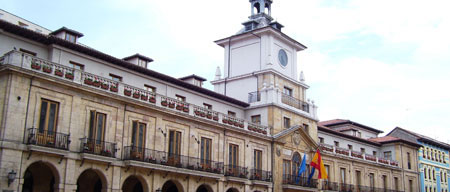Home > Study in Spain > City Guide > Oviedo
Oviedo City Guide
- Places of Interest
- Maps
- Getting to
- Getting around the city
Said to be one of the most fantastic cities in the north of Spain, it is impossible not to love Oviedo. Famous for its green landscape; grand, historical buildings, and of course its "sidra", the Asturian capital has so much to offer. Unlike its working class neighbours, Oviedo has a long history of wealth, something evident in the grandeur of its buildings. The old quarter is a maze of narrow streets and old squares, all built in warm yellow stone, and made all the better as it is completely pedestrianised. The whole city is full of excellent bars and restaurants, many of them aimed at the lively student population, which is comprised of students from all over the globe.
The city is said to have been founded by two monks in 761, completed with the construction of a church dedicated to Saint Vincent. However, evidence of a settlement can be traced back as far as the first century. King Fruela I of Asturias was the first clear promoter of the city, building a palace and a nearby church, although Oviedo was transformed into a capital when King Alfonso II The Chaste moved the court to Oviedo from Pravia, and importantly, created the Pilgrim's Route to Santiago de Compostela, quite literally putting Oviedo on the map. The city flourished architecturally under the rule of King Ramiro I, demonstrating Nordic, Visigothic and Roman influences in signature buildings, many of which still remain today. The establishment of the University of Oviedo at the beginning of the 17th century encouraged an urban expansion which continues into today.Oviedo is unlike anywhere else in Spain. Come to discover this beautiful city and explore the fascinating region of Asturias; we know you'll end up wishing you could stay forever.
Places of Interest
Cathedral of San Salvador
An important place on the Pilgrim's Route to Santiago de Compostela, this Cathedral was built under the rule of King Alfonso II The Chaste. A mixture of styles, from Prerromanesque to Baroque, it is a stunning piece of architecture, with plenty of interesting features. Make sure you don't miss the western tower, said to be one of the best examples of Flamboyant Gothic in Spain, and the upper part of the Holy Chamber, where you can see a fine collection of Romanesque column-statues.
Cámara Santa
Situated next to the cathedral, this old palace chapel houses the jewels and treasures of the next door cathedral, a job it has been doing for the past 1200 years. It was declared a World Heritage Site by UNESCO in December 1998.
San Miguel de Lillo and Santa Maria del Naranco
Two churches situated on the slope of Mount Naranco, built by King Ramiro I. Made a World Heritage Site by UNESCO in 1985. They can be accessed by foot, but there is also a bus from the train station (number 10) which takes you there.
La Foncalada
9th century fountain. The only preserved Pre-Romanesque civil work in the whole of Europe.
House of the Llanes
Said to have the best Baroque façade in the whole of Asturias.
Bulevar de Sidra
Head to Calle Gascona, where you will find a multitude of places where you can sample Asturias signature drink, Cider. To go with it, try a Chorizo a la Sidra or a Fabada bean stew.
Museums
Museo de Bellas Artes de Asturias
Set in three buildings across the old quarter of the city, this museums houses one of the finest collections of artwork in Spain, with pieces ranging from the Middle Ages to modern day.
Museo Arqueológico
Situated since 1952 in the Benedictine Monastery of San Vicente. Contains a range of arqueological artefacts spanning a lengthy time period, as well as sections for Asturian Ethnography, Heraldry, Medieval and Modern Epigraphy and Armour.
Maps
Getting to Oviedo
By Air
Many low cost airlines fly to Asturias airport. This includes both internal flights to Madrid, Barcelona and a variety of other destinations in Spain, as well as international flights to places such as Brussels, London Gatwick and Paris-Orly. Oviedo is connected to Asturias airport with a bus which costs 9€ or 1.50€ with a TCA card, which is worth getting, especially if you are in a big group.
By Train
RENFE runs trains directly to and from Madrid, Barcelona and Alicante. There is also a Cercanías service which runs through Asturias.
By Bus
ALSA and Intercar run national services between Oviedo and León, Valladolid, Madrid, Barcelona, Zamora, Salamanca, Cáceres, Badajoz, Sevilla, Lugo, La Coruña, Santiago de Compostela, Pontevedra, Vigo and Tuy; as well as international services to and from Paris, Brussels, Geneva and Zürich. There are also a multitude of companies which run regional services to more local destinations.
Getting around the city
Although the best way to get around Oviedo is on foot, there is also a cheap, comfortable bus service in the city. You can go anywhere for 85 cents, and for even less if you purchase a bus card for any number of rides at a newsstand. Taxis are also widely available in the city and a journey to anywhere in the city will never be more than 6€.
Tips
September is a fantastic month to be in Oviedo as the weather is perfect and the San Mateo Festivities are taking place, which involve a variety of sporting and cultural traditional spectacles. The San Juan Bonfires on the night of 23 June are also interesting, as people crowd round bonfires in the street (the most famous being in the Plaza de la Catedral) and perform traditional dances around them.

